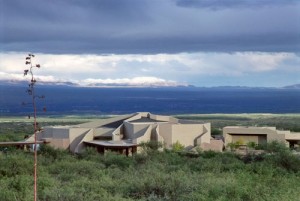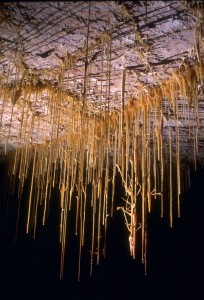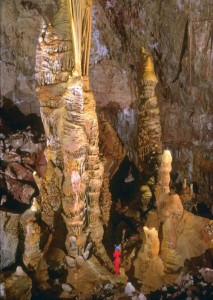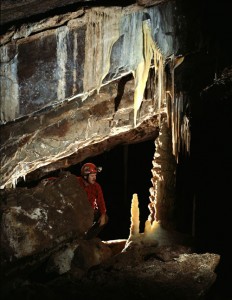By Greg Brown

The Kartchner Caverns Visitor Center is located south of Benson, Ariz., at the base of the Whetstone Mountains (out of view).
“Hello, Greg?” came the thickly accented voice. “It’s Elvy Kjellander, calling from Sweden. Roland and I will be in the U.S. this month, and would like to visit you and Jean.”
It’s been 30-odd years since my wife Jean traveled to Sweden as a Rotary Exchange student. Elvy and Roland, her “Swedish parents,” live in the small city of Hudiksvall, where Elvy taught high school and Roland was the principal. After so many years hearing of Jean’s Swedish adventures, I feel like I was there by her side, cross-country skiing to school, and plunging naked in wintertime from hot saunas into icy waters of a nearby pond.
Both Roland and Elvy speak excellent English, but neither revealed it for months after Jean first arrived, so she’d master the Swedish language. In fact, when I first met Jean, she was fluent. I remember picking up some young Norwegian hitchhikers shortly after her return from Scandinavia. The languages are similar enough that Jean could eavesdrop on our passengers’ supposedly private conversation. For maximum effect she chimed in only after they began gossiping about us. (If only I had a photo of their expressions.)
To refresh her language skills for Elvy and Roland’s upcoming visit, Jean dusted off her old grammar books and monitored Swedish radio stations on the Internet. This would be only the Kjellanders’ second visit to Arizona.
“Let’s fly them somewhere exciting!” bubbled Jean.
One compelling destination came immediately to mind: the newly inaugurated “Big Room” tour at southern Arizona’s Kartchner Caverns. Unlike our previous Kartchner visit, which required a 30-mile drive from Sierra Vista, Benson Municipal Airport now offered landing facilities only 13 miles away. After phoning Elvy and Roland to confirm their comfort with flying, I made reservations.
The sky misted grey with rare desert rain the morning we steered our honored guests skyward. Although cloud ceilings were high, I’d readied my instrument charts in case they were needed. I’d also phoned Benson to check weather conditions.
“Just a high overcast,” said the pilot who answered. “If it lowers, fly via Tucson around the Catalina Mountains.” That would distance us from 9,225-foot Mt. Lemon.
My one previous flight to Benson had been years earlier, to celebrate ribbon-cutting at the then newly opened airport; in fact, the Flying Carpet was only the second airplane ever to land there. At the time, the airport had only a spanking new runway and ramp; no buildings yet interrupted rangeland stretching to the horizon.
To spice up speeches and plaques, the city fathers served fiery chili barbeque, with plenty of soft drinks to wash it down. It was a stirring event, but when the time came to take off, I realized with consternation that there were no restrooms, porta-potties, or even a bush to hide behind. Gritting my teeth, I’d trekked across open country seeking relief, which, thankfully, I found in a small hollow beyond sight of the airport crowd.
These days Benson Airport is a bustling general aviation facility, boasting fuel, maintenance and T-hangars. A DC-3 dominated the tie-down ramp when we landed with our Swedish visitors, and a modular terminal building offered not only bathrooms, but also two courtesy cars.
“No cracked windshield?” I asked manager Nancy Martin, as she handed me keys to one of them.
“Just had it replaced,” she replied with a smile.
Minutes later, we arrived at the Kartchner Caverns Visitor Center.
Two amateur cavers discovered what’s now Kartchner Caverns in 1974. In a rather amazing conspiracy with property owners, state authorities and lawmakers, they managed to keep the gem secret until it opened as a state park 25 years later. Modern technology helps preserve the “living cave” ecosystem by sustaining natural temperature and high humidity. Air locks, guided tours and restricted visitor access keep the cave pristine, and portions are closed during the summer to allow indigenous Myotis velifer bats to mate and nurse their young.
Although smaller than its better-known limestone cousins, Carlsbad Caverns and Mammoth Cave, Kartchner Caverns ranks among the top 10 caves in the world for its number and variety of speliothems (calcite formations). Of those 10, Kartchner is the only one open to the public. Sure enough, to our awe, on the one and one half hour tour, the cave dripped with stalactites, “soda straws,” stalagmites, “fried eggs,” “cave bacon draperies” and innumerable other formations spanning colors of the rainbow.
Skies had cleared by the time we emerged into daylight, so after a brief hike, we decided to fly the “back way” home, around the east side of Mt. Lemon. We had hardly turned on course when the low voltage light illuminated.
“I thought that was fixed!” exclaimed Jean, referring to the maddening intermittent electrical fault that had plagued us for months.
“Apparently replacing the circuit breaker didn’t cure the problem,” I said, discouraged.
This time, however, the charging circuit mercifully failed for good. Jean retrieved the portable GPS and our newly acquired handheld backup radio, and with the master switch off, to preserve battery juice for our return to Phoenix, we proceeded homeward. I’ve never been happier to part with hard-earned money than when our mechanic phoned the next morning to say he’d finally solved our problem.

Delicate “soda straws” hang from the “Throne Room” ceiling. Kartchner Caverns possesses the world’s second longest known soda straw, at more than 21 feet long.
“We replaced your alternator,” he said. “Now everything should be fine.”
I hope he’s right, but we’ll keep the portable backups handy for some time to come. To our relief, the electrical problem added only to the day’s adventure for our Swedish visitors. Roland just shared a knowing look when the power went out, and Elvy continued reading. After landing, Roland delighted in troubleshooting electrical connections alongside our mechanic, and photographing the process. Later he’d compliment Jean on our teamwork in handling the malfunction. Judging by their beaming faces on the drive home, Elvy and Roland enjoyed our over-and-underground excursion as much as we did. May our delightful Swedish parents visit again soon.
Schedule your own Kartchner Caverns tour at [http://www.azstateparks.gov]. For further information, including a virtual tour, visit [http://www.explorethecaverns.com]. Author of numerous books and articles, Greg Brown is a columnist for AOPA Flight Training magazine. Read more of his tales in “Flying Carpet: The Soul of an Airplane,” available through your favorite bookstore, pilot shop, or online catalog, and visit
[http://www.gregbrownflyingcarpet.com].















